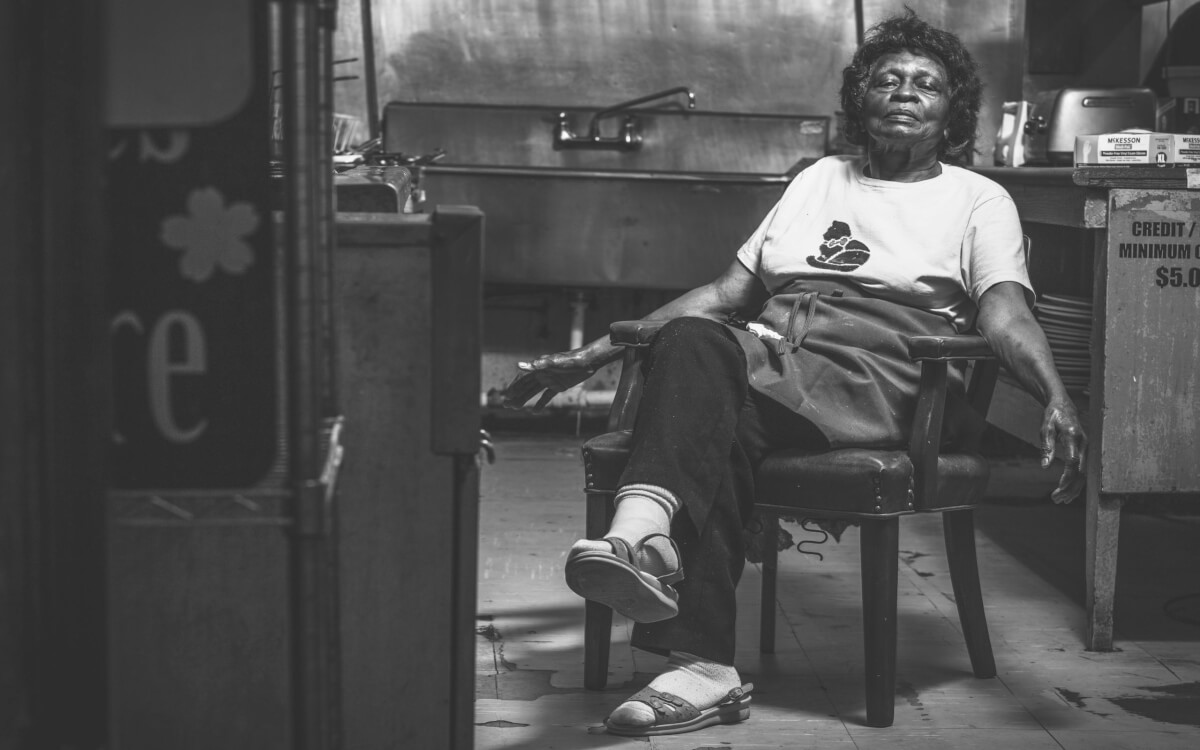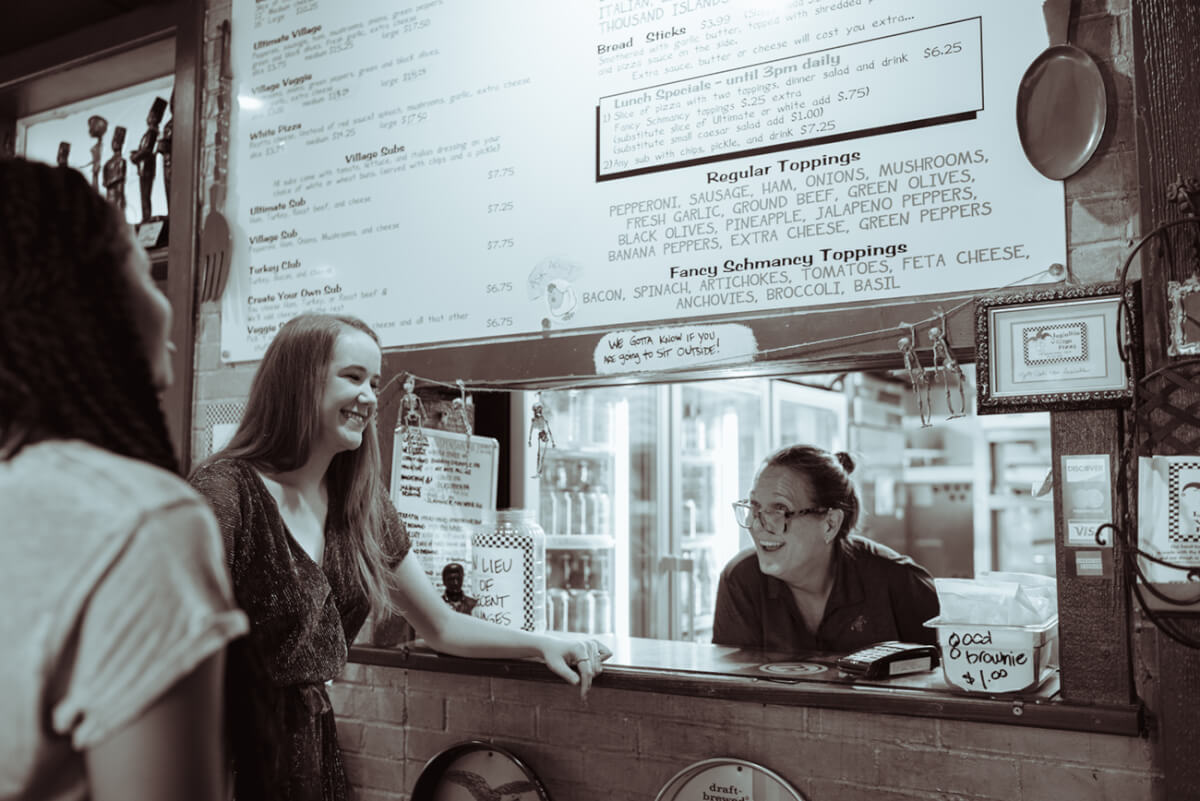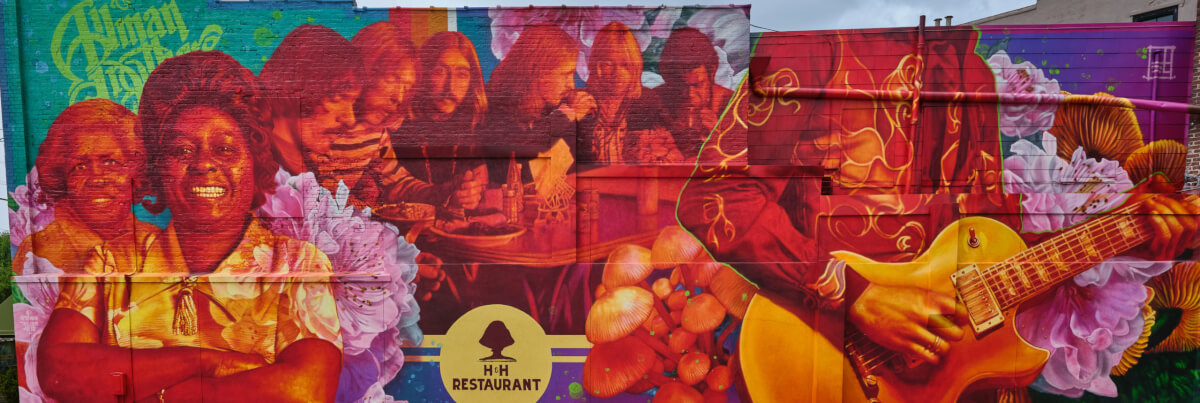
Macon music on the menu
By Candice Dyer
Photography by Matt Odom
Louise Hudson glanced up from the kitchen of the H&H Restaurant and immediately noticed six skinny, long-haired boys at her table.
They looked hungry and broke. Several of them were shyly picking food from just one plate. Taking pains not to embarrass them, Hudson, known to all as “Mama Louise,” brought more tableware and generously ladled out greens and smothered fried chicken, and then refused to charge them. This first “loaves and fishes” gesture for the Allman Brothers Band would sanctify H&H in the South’s music landscape.
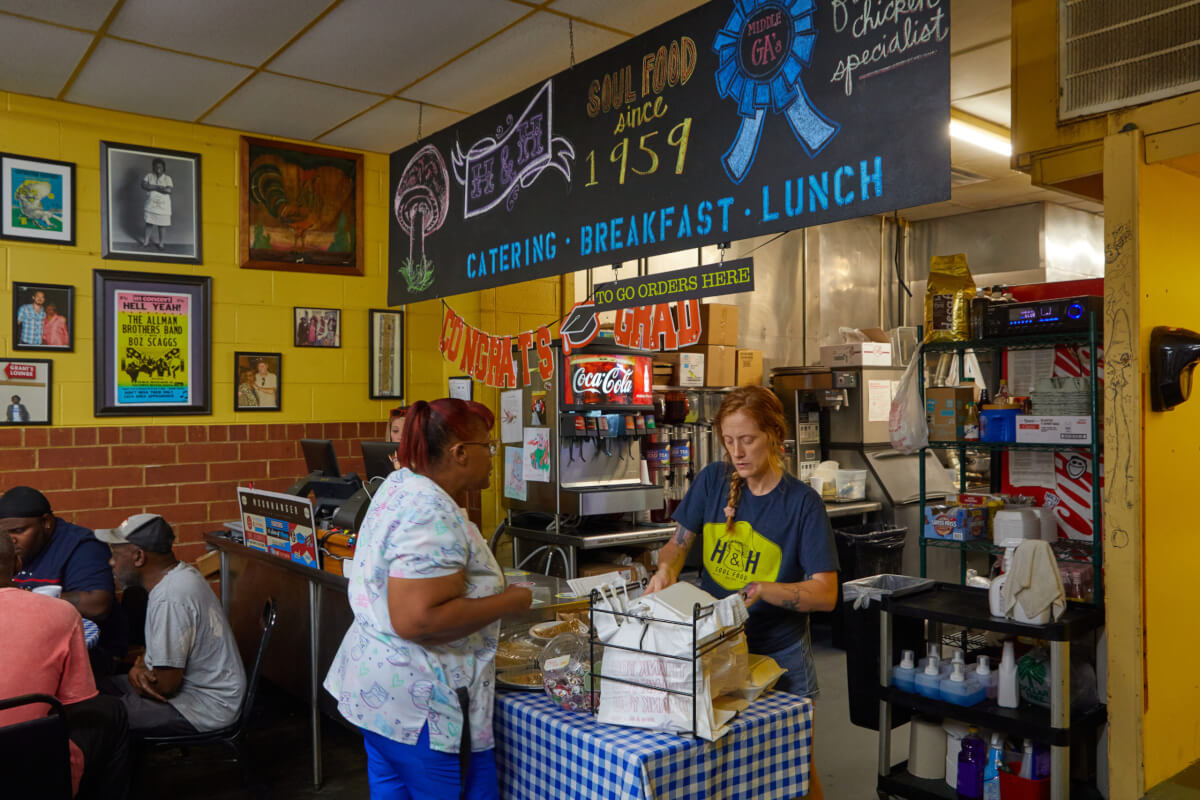
NO ONE WENT HUNGRY AROUND HER
“It’s such a sweet story of how Mama Louise saw them sharing a plate because that was all the band members could afford, and she gave them food,” said Scott Freeman, author of Midnight Riders: The Story of the Allman Brothers Band. “For me, it represents Mama Louise’s personal code and sensibility and generosity of the spirit. I think it also symbolizes how many folks in Macon’s Black community embraced the Allman Brothers. Like themselves, the Brothers were outsiders in mainstream Macon and the fact that the group had a Black drummer was part of that as well.”
Hudson opened the soul food eatery in 1959 with Inez Hill, or “Mama Hill,” and together they formed a dignified matriarchy unfazed by the startling sight of Macon’s first hippies. Word of the women’s kindness spread quickly around the water cooler at Capricorn Records, where Gregg Allman was effectively promoting his theory that a pork-heavy diet makes for better blues vocals. Macon in that era, with its columned mansions and “Old South” vibe, seems an unlikely setting for a newfangled word like intersectionality, but Hudson, who was 40 at the time, and the growing number of young men breezing into town trailing long, cornsilk hair enjoyed a special friendship that transcended race, gender and age.
“Mama Louise did more than feed and nurture a ragtag group of musicians,” said keyboardist Chuck Leavell. “She felt the spirit of the time. Blacks and whites were working together, playing music together. It was almost like a religion. And Louise’s cooking was a sort of soul food sacrament. No one went hungry around her.”
Music promoter Gary Montgomery said he still feels wistful, just thinking about those times. “Fried chicken, ham hocks and the best possible bread pudding, and she’d mix lemonade with iced tea. If you were really family, you came through the back door and through the kitchen to get your hug first and then place an order.”
(You were also expected to use the back door if you were noticeably tripping on Psilocybin. Not that there was any shame to that; “The H,” as it was known, eventually incorporated a mushroom into its logo.)
“I didn’t have a mama, and she came along when I sorely needed one,” recalled GRAMMY-nominated country and blues singer Lee Roy Parnell. “When I was 17, I ran away from home to seek my fame and fortune in Macon. I was a little, skinny, redheaded guitar player who needed some guidance, and she pretty much kept me on the straight and narrow most of the time. I couldn’t stand the thought of letting her down. During that beautiful time in our lives, all of us musicians became brothers and sisters, and Mama Louise held dominion as our communal mama, as the queen of that strange and wonderful hamlet. It was all about being fed, and I don’t just mean with collard greens. She nourished our souls. Mama Louise still represents Macon to me. It’s a city with such a deep wellspring of music, friendship, and spirituality. If it doesn’t touch you, you probably don’t belong there.”
Before his death, psychedelic rocker Col. Bruce Hampton told a reporter, “It’s no exaggeration to say Mama Louise kept me alive in the seventies. Back then, she had sacks that you sat on. Grain sacks, I guess. I remember the meals costing about 50 cents. Nobody had any money, really, so we’d just pay her a week or so later, after a gig. She’d fix breakfast, too, at some ungodly hour like 4 a.m., and Bunky Odom would be the only one there. I think of her as the Mother Teresa of Macon, with her grace and humility. Just watching her run the cash register was a religious experience for me.”
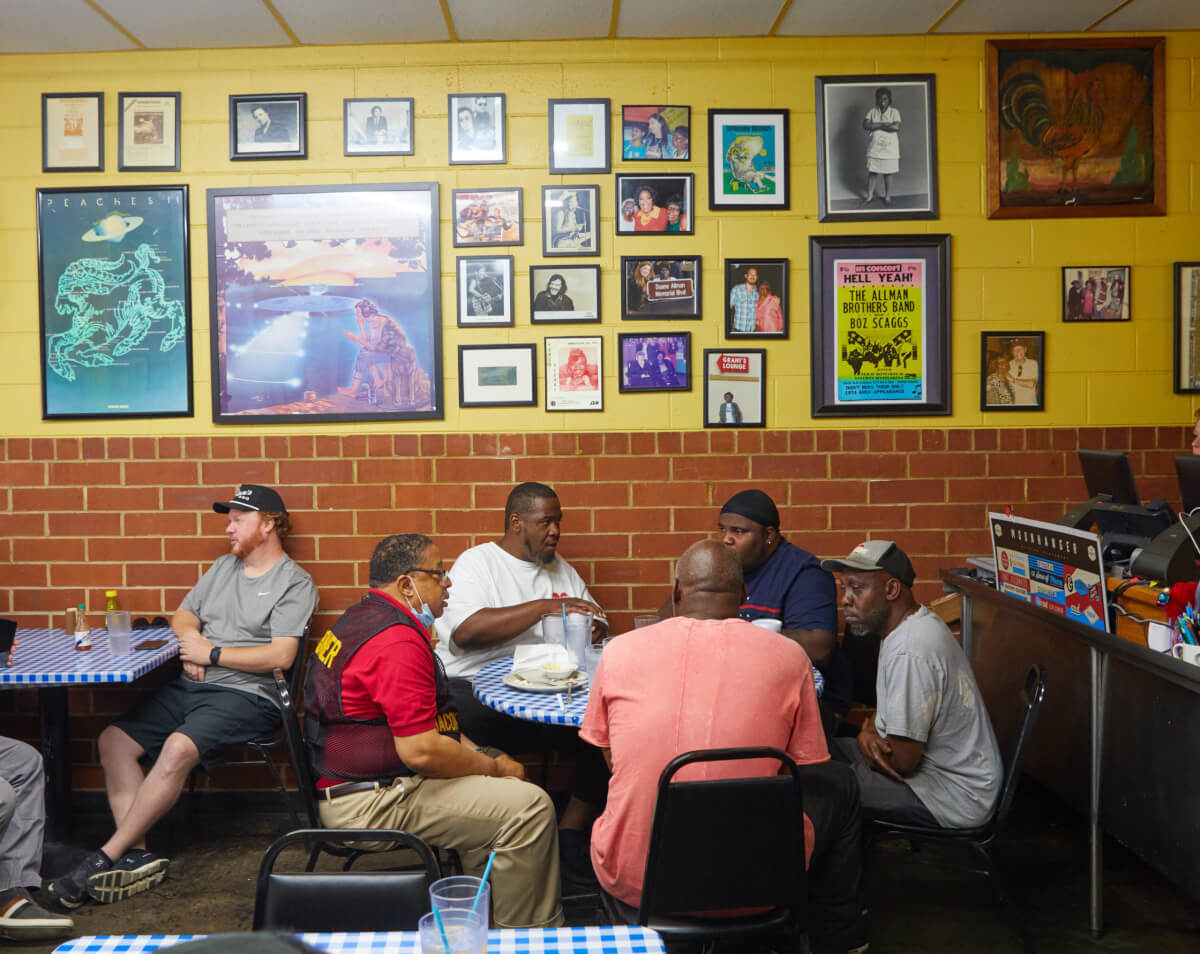
THEY COULD BE BAD MEN, BUT THEY WAS ALWAYS SWEET BOYS
For her part, Hudson got the adventure of a lifetime. Soon enough, all of these shaggy kids were more than able to pay their tab. When the Allman Brothers headed to California on a leg of their 1972 tour, they took her along. The plan was for her to cook for a L.A. press party, but she was having too much fun to work.
“I just went around with the band,” she told a reporter in August of that year. “We didn’t do much sight-seeing. We mostly just loafed around the hotel and went to the pool and the lounge. I love the Allman Brothers’ music and that sweet voice Gregg has behind it. Every album they make, they give it to me.”
They did more than that. On the cover of their second album, “Idlewild South,” the band immortalized her in the credits: “Vittles: Louise.”
“They was sweet boys,” she liked to say, adding mischievously, “They could be bad men, but they was always sweet boys.”
Alan Walden, impresario behind Lynyrd Skynyrd, remembers those times. “When Led Zeppelin would tour on a Starjet, they would bring along chefs from Italy and France,” he said. “ Well, the Allman Brothers took Mama on their jet, and I always admired the class they showed in doing that.”
John T. Edge, founding director of the Southern Foodways Alliance and author of several books, including “The Potlikker Papers: A Food History of the Modern South,” grew up in Macon and ate regularly at the H&H.
“My father loved the creamed corn, so we ate there whenever I was not in school, and he would banter with Mama Louise,” he said. “The food was good, of course, but it was more about what had transpired there than it was the candied yams. The H&H was the front porch of an integrated Georgia, serving the promise of what can happen if Black and white gathered together to conceive a future. The place is a symbol of the future-tense South.”
Since that time, the earthy grande dame who addresses everyone as “baby,” “dear heart” and “darlin’”– often within the same sentence – has wielded her spatula and drawled sing-song beatitudes for countless pilgrims, including Oprah Winfrey. For one of Hudson’s birthdays, Mayor Jim Marshall issued a proclamation conferring an additional title that made her aristocracy official: “Lady Mama Louise.”

Matt Newtown, director of operations – Moonhanger Group; Lindsie Broughton, assistant manager – H&H; Tangie Myers, general manager – H&H; Jerry Davis – H&H; Wes Griffith, owner – Moonhanger Group
KEEP DOING GOOD
Despite the place’s ongoing popularity with mojo-seekers, it was looking as if the landmark might vanish into the memories of rockers with graying ponytails. Mama Hill died in 2007, and Mama Louise, struggling with health-related issues, closed the restaurant in 2013. Happily, though, The Moonhanger Group, an outfit of preservation-minded entrepreneurs led by Wes Griffith, took over the property the following year. For a while, Mama Louise played an emeritus role at the fryer and held court until she retired.
“The H&H is such an important part of Macon’s cultural and artistic heritage that we couldn’t stand the thought of losing it,” said Griffith, whose father worked with Phil Walden at Capricorn.
Last year, to make the shrine complete, Griffith commissioned a mural for the side of the H&H building. The result is a stunning 30-feet-by-77-feet portrait of Hudson and Hill, with the Allman Brothers on the side, completed by artist Steven Teller. He drew inspiration from photos taken by Twiggs Lyndon, the Brothers’ tour manager.
“The women are up front because I wanted them to be the primary presence,” Teller said, noting that he added several mushrooms and some subtle peach blossoms to allude to the Eat a Peach album. He used an estimated 50 colors in the painting, with an emphasis on warm tones and a mood of psychedelia. It is coated with thick polyurethane to stand up to weather and vandals.
Teller, 31, a longtime Allman Brothers fan, calls this project “serendipity.”
“In 2010, I was on my way home from a Phish concert, and my car broke down in Macon,” he said. “I asked a guy who looked like an old hippie where to eat, and he sent me to the H&H, where I met Mama Louise. So I encountered her truly in her element. Later, when I got the Moonhanger email asking if I’d be willing to paint a mural, my mind was, like, literally blown. Of course, I was honored.”
Teller has painted murals from Miami to Chicago but cites his Macon work as “special.”
“I couldn’t believe the turn-out when it was unveiled in February,” he said, “but they were there to support Mama Louise, not me. It’s an incredible feeling to be part of something so uplifting in a small, close-knit community, where you can really feel its impact.”
Now in her 90s, Hudson no longer gives interviews, but her legacy rocks on. A prep cook at The Rookery caught Griffith’s eye. Tangie Myers was known for making savory “family meals” for the back of the house – a “cook’s cook.” She was tapped as executive chef for the new H&H, where she has tweaked the menu and added several items to it.
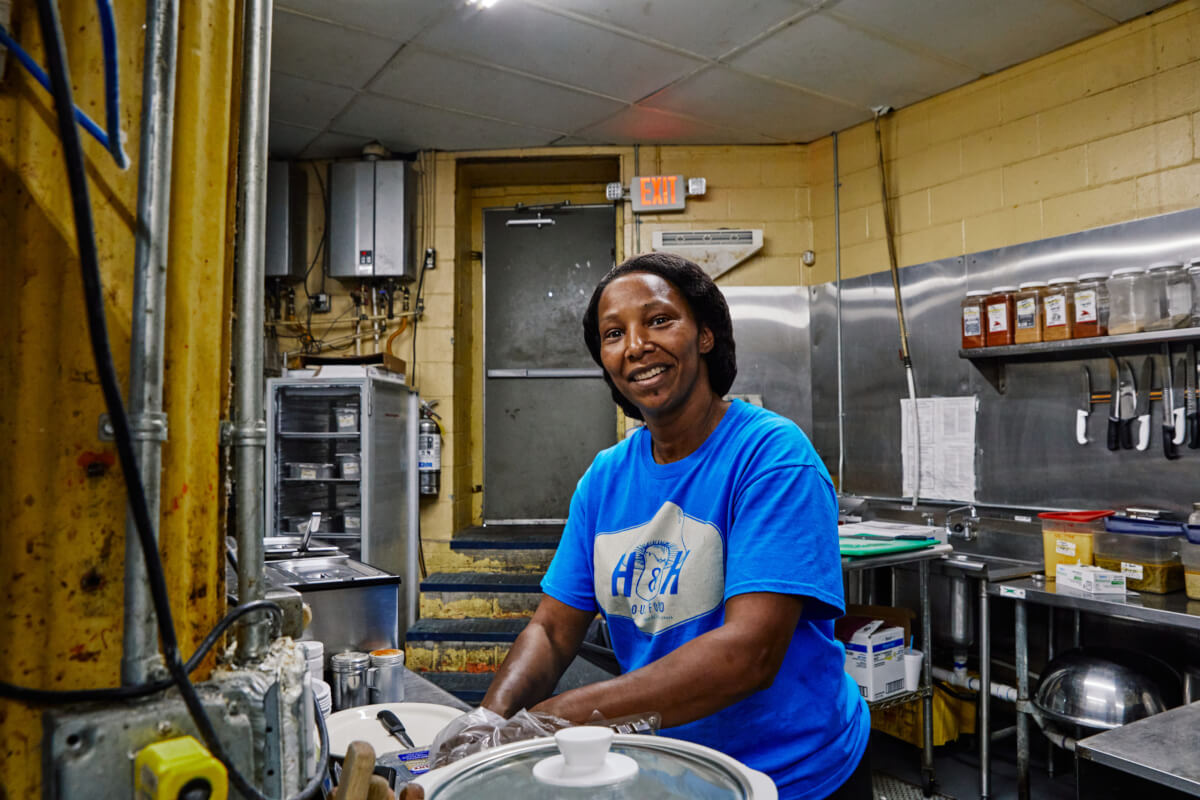
“It was started by two strong, African-American women, and we wanted to keep that tradition going,” Griffith said, referring to Myers, a Charleston native of Gullah-Geechee descent.
The mushroom logo remains, as does a code of hospitality and generosity.
“We need to keep telling this story,” said Myers, who will not hesitate to give away food to people who seem down and out. “I feed the homeless who show up, and every time I do, I feel Mama Louise smiling at me and saying, ‘You’re doing good. Keep doing good.’”
